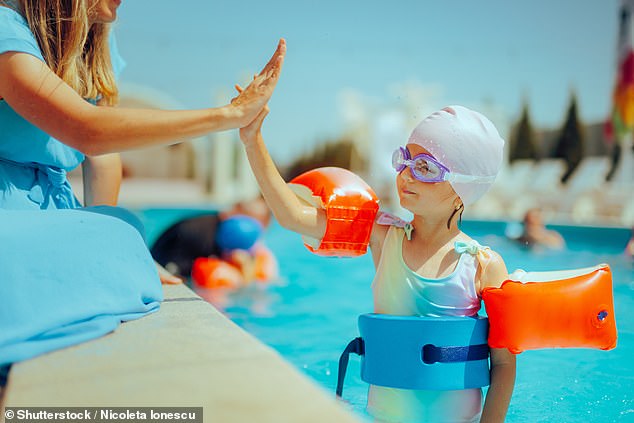With swimming season upon us, a former paramedic has issued an urgent water safety warning to parents – and offered a simple strategy to keep children safe.
Mother-of-three Nikki Jurcutz, who spent eight years as a paramedic with Ambulance Victoria, explained the simple but effective swim safety rule that she recommends all families implement as a non-negotiable.
It takes only seconds to follow this rule – and yet it could make all the difference in potentially saving a child’s life.
Her suggestion? Teach your kids that they must high five you before going in the water.
The safety tip was shared in a recent TikTok video posted by Tiny Hearts Education, an organisation co-founded by Nikki that offers first aid and CPR courses to parents.
The post saw Nikki elaborate on exactly how her water safety high five rule for families works.
‘Being a paramedic shaped how I parent my kids and this one is such an easy one to teach your kids from an early age. No high five, no swimming,’ she said.
Daily Mail spoke further to Nikki about how the simple act of a high five could be a potentially lifesaving act.

With swimming season upon us, a former paramedic has issued an urgent water safety warning to parents – and offered a simple strategy to keep children safe

The simple rule? ‘Teach your kids that they must high five you before going in the water’ (Picture: stock image)
‘Strategies like the high-five rule help build habits whereby supervision is never skipped and a child never enters the water without a trusted adult.
‘At Tiny Hearts, our message is that the best way to prevent tragedy is through preparation and proactive safety.
‘Small actions, like making a poolside high-five part of your family routine, create layers of protection that can save a child’s life.’
Heartbreakingly, the majority of drownings that involve children occur when a parent is in the nearby vicinity, but isn’t actively supervising their children around water.
’86 per cent of drownings happen when a parent is present meaning little ones silently slip away and enter the water without a parent knowing or watching,’ she explained in a post.
Contrary to popular belief, Nikki confirmed to Daily Mail that when this occurs, the ‘drowning is often quick and silent’.
‘It happens in less than 20 seconds and five centimeters of water,’ she said. ‘It doesn’t look like the big splashing we see in the movies.’
The high five rule therefore attempts to prevent this scenario because the child would be unable to swim without first alerting their parent.

The goal of the high five rule is to prevent the potentially tragic scenario where a child goes into the water, without a parent actively supervising them (Picture: stock image)
The parent on the receiving end of the high-five has therefore been properly informed that their child is about to enter the water and thus requires their full attention.

Ex paramedic Nikki Jurcutz (pictured) co-founded Tiny Hearts Education, which offers child safety focused first aid and CPR courses
The post further described how the rule in their family extended to their children only being allowed to high five a parent – and not any other adult – before swimming.
‘I say it needs to be me or my husband they high five.’
The recent TikTok post was shared over 14,000 times, with many parents praising this simple but clever rule to keep kids safe around water.
‘Brilliant idea – thank you,’ replied one mother.
‘I love this! So simple,’ another mother agreed.
A professional lifesaver also replied in response to the water safety rule.
‘As a lifeguard, I second this,’ they said.
Other responses offered up similar alternative ideas that they have implemented.
‘As a [swimming] instructor, the first step of each session is the kid has to ask an adult for permission to go in the pool,’ one swim teacher explained.
‘My social worker and paramedic parents had a rule we couldn’t get in the water unless one of them was already in and gave a thumbs-up. I still automatically look for it before swimming,’ another person added.
